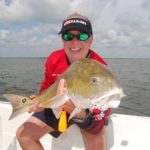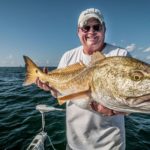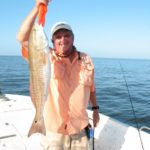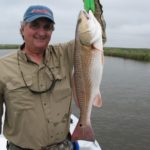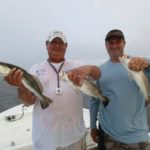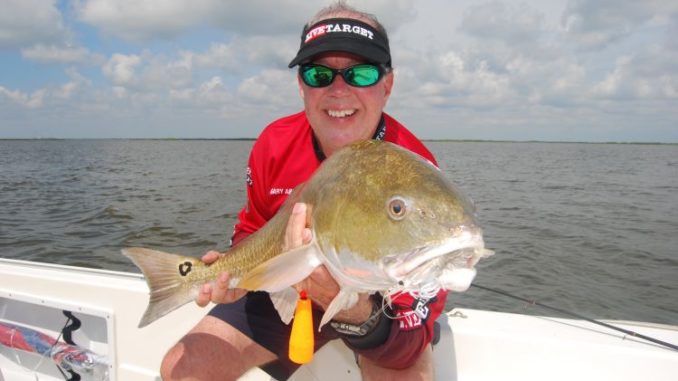
This is a transition month, with unpredictable weather and sometimes tough fishing. But this guide knows the passes fill with enough big redfish to keep anglers busy — and he understands what it takes to add some trout to the box, as well.
September can be a stressful month. We’re in the peak month for tropical activity — a fact that keeps most of us glued to the daily weather forecasts, and a significant stress producer in itself.
Plus, all the kids and students are back in school. Traffic is heavier, commute times are longer, and the Saints, LSU, Tulane and all our favorite prep and college teams are back on the football field, increasing our anticipation and anxiety.
And if you’re a fisherman, September issues another challenge: It’s another of those dreaded transition months, when even the fish themselves act stressed and don’t seem to know what to do.
Down here in Southeast Louisiana, we mostly use the word “transition” as a synonym for in-between. Basically, it means the trout we chased in the bigger water near the Gulf over the summer ain’t dere no more.
But they’re not deep in the inside waters yet, either.
So where are they? Somewhere in-between.
Sparked by some instinct, they begin transitioning from the beaches and bays toward the interior waters where they’ll set up shop for the winter, as they’ve done for millenniums.
The challenge is that trout tend to be much more scattered in September, smaller in size, far less likely to school up in any significant numbers and more skittish.
It makes every anglers job more challenging — and even when we do find fish it’s generally just a handful in any one place.
Add to all of that the fact that it can still be sweltering hot, the humidity is unrelenting and often onerous winds.
Yep, that pretty much describes September.
But while all these factors are definitely in play, a few places seem to be bucking the trend — in particular, Grand Isle.
Charter Capt. Jay Auseve (985-637-7142) told me he caught both speckled trout and redfish last year in the surf all through September, and even through much of October.
And he didn’t just do that occasionally but consistently.
What’s more, he invited me to see for myself. So, that’s how I found myself and my friend Vic Rodrigue at the dock of Bridge Side Marina just as day was breaking on a very windy, overcast morning.
Auseve has lived on Grand Isle since he was 15 years old, when his dad bought a camp there so they could take up residence and fish there each summer.
But they loved the life and never left. He’s been a charter guide for more than 20 years, originally taking clients offshore. But he sold his big boat several years ago to focus exclusively on inshore fishing.
Auseve was waiting with his long-time Baton Rouge fishing buddy Danny Kais. We watched the weather for a bit to see if we could get on the water without being pounded by early morning storms that have been prolific of late, and when we saw a break in the clouds we loaded our gear into his Blazer Bay and took off.
Our initial goal was to patrol the beach along Elmer’s Island, where Auseve said he’s been catching some big reds and specks in the surf.
“Usually the bull reds get up along the beaches starting in August and into September, and then they move into the passes,” he explained. “Right now, you can actually catch them in both places, and on the beach we’re still catching some nice trout along with them.”
“So far the fish are still in the surf, and we hope they’ll stay till October like last year. But who can tell? Conditions aren’t always the same: Some years we get more winds or more south or east winds, and anytime we get a lot of wind from those directions it brings big waves from the Gulf and muddies up the water and that messes up the fishing on the beach. So then you have to look elsewhere for fish — and, fortunately, we do have options.”
Multiple storms had the winds stirred up, and huge swells quickly made it apparent that we wouldn’t be fishing the beach that day.
I could see the disappointment in Auseve’s face when he pointed the bow of his boat toward more-protected water.
There were bull reds in the surf and some big trout stragglers, too, but we’d be hunting elsewhere that day.
“All along the rocks has been pretty productive, also,” the guide said. “I troll along them and cast live shrimp under a cork, and when I get a hit I stick the Cajun anchor. Or I just anchor up and fish a spot.
“Same bait, about 18 to 24 inches under a cork — or you can free-line a live croaker. But if you use croakers you can’t pull the trigger too fast. That is, don’t set the hook immediately when you get a tug on your line. Be patient; specks will hit the croaker first before they inhale it. Wait till he comes back and actually starts swimming away with it, then set the hook. You’ll likely pick up some nice specks in the mix there, too.”
Bullies in the passes
But Auseve says perhaps the main attraction this month are the bull reds that move into the passes and make it home.
“This is one of the best times of the year to fish the passes for bull reds: Barataria Pass, Coup Abel, Caminada Pass, Four Bayous — all of them will hold fish, and these bulls are running in the 30-35 pound class,” he said.
Auseve said the best approach is simple.
Just use your depth sounder and anchor off the sandbars in about 12 feet of water, and then cast your bait toward the sandbar into 8 to 10 feet of water.
“The fish are hanging along the ledges of the sandbars, ambushing bait,” Auseve said. “It’s important to bring some stout gear; if you are fishing with light gear you’ll wear out your drag and they’ll tear up your line.
“I use a heavy-action rod and a spinning reel in the 4500 to 5000 class. I also like to use an Ambassador 7000 baitcasting reel in the passes.”
His line is equally as rugged.
“Whatever (reel) I use, I spool it up with 60-pound braided line, and I use 80-pound mono leader, a 6- to 8-ounce sinker Carolina rigged and a No. 9 hook baited up with cracked crab or, if they’re small, a whole crab or cut mullet,” Auseve explained. “And I prefer to fish the passes on an incoming tide.”
The action can be hectic.
“Some days we take customers out to catch bull reds and let them wear themselves out fighting those big fish in the passes,” Auseve said. “It’s all catch and release because you can only keep one per person, and most folks fish them just for the thrill.”
While we talked, Auseve was drifting and trolling a section of marsh, putting us on a good trout bite.
The trout seemed to concentrate in tight pockets: You had to throw almost right on top of them in a small area to get a bite.
“That’s how it’s been lately,” Auseve said. “The speckled trout have been schooled up in tight bunches both in the marsh and along the beach. We fan cast on all sides of the boat until we get hits and then we focus on that spot.
“If you cast just a boat length away you’ll miss them. So once you catch a trout, keep hammering that spot for as long as it produces. When the action ends, start fan casting again and resume your troll or drift until you find them again.”
On the beach and in the marsh
The trout will start moving into the marsh this month, but plenty of fish will still be on the beach.
“I believe some really never leave the beach,” Auseve said. “The Barataria Bay Islands, Cat Bay, Independence Island, the Caminada Bay reefs, Timbalier Bay — all that will be good this month. Mostly trout, but some reds, too.
“Fish it all under a cork with live shrimp.”
Auseve said that, if you can run the beach, look for seagulls diving over bait and any sign of baitfish or shrimp in the water.
Use live croakers or live shrimp on a Carolina rig.
“I generally use a 3/8- or ½-ounce sinker, but when the tide is strong I’ll use up to a 1-ounce sinker,” he said. “And I’ll bring some live croakers if they’re not too big, but I’ll always take live shrimp as long as its available.
“In July and August, the croakers will often produce bigger trout, but September is a question mark. Some days they’ll eat up those croakers, but every day they’ll eat up shrimp. And if you are fishing or searching and you see shrimp jumping, then that’s what you want to toss because that’s what they’re feeding on.”
We had to interrupt our expedition when dark and nasty thunder-boomers got too close for comfort. It looked for a while like we’d have to run through a pretty serious, lightening filled thunderstorm, but God was gracious and allowed us a small window through which to escape before the skies exploded.
I like the old adage: Live to fish another day.
